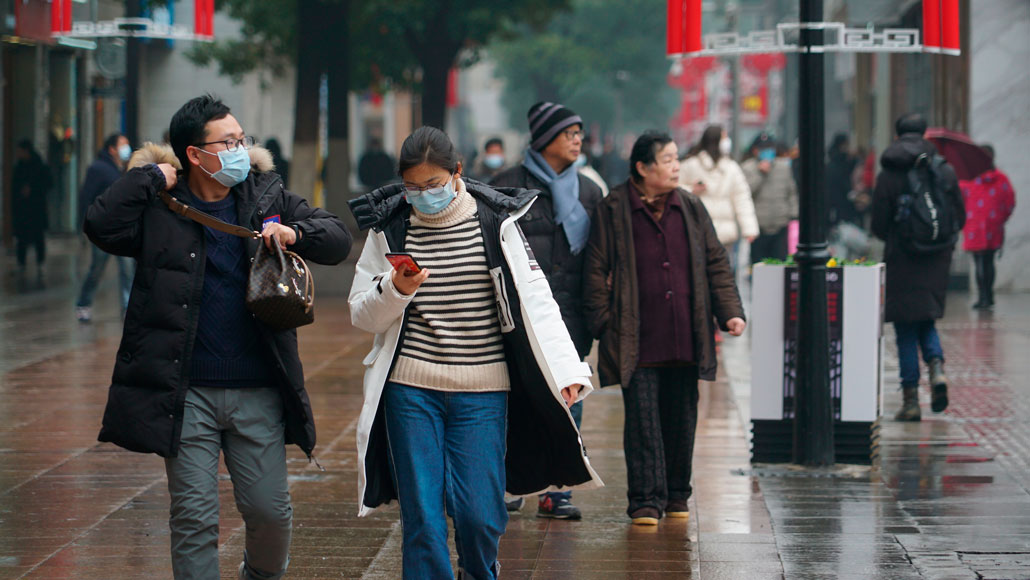People who didn’t know they had COVID-19 drove its spread in China
A new simulation shows why rapidly expanding social distancing measures are crucial

Pedestrians stroll along a street lined with shops in Wuhan, China, on January 22, before government officials implemented measures to combat the spread of the coronavirus. In this early stage, the outbreak was driven by undetected cases, researchers report.
AP Photo/Dake Kang
- More than 2 years ago
Mild cases of COVID-19 that go unrecognized are fueling the coronavirus pandemic, a new study of the early days of the outbreak in China suggests.
It’s this stealth transmission from undetected cases that U.S. officials are now scrambling to limit with a slew of recently announced social distancing measures (SN: 3/13/20). On March 16, the White House coronavirus task force advised people to avoid gatherings of more than 10 people for the next 15 days. States including Pennsylvania, Ohio and New York, as well as Washington, D.C., have shut down bars and restaurants. And on March 17, a shelter-in-place order affecting close to 7 million people in the San Francisco Bay area went into effect. Similar efforts have been taken around the globe.
In the new study, researchers used data on people’s movement in China from January 10 to January 23 to simulate how SARS-CoV-2, the virus that causes COVID-19, spread before restrictions on travel within the country and other isolation measures were implemented. Undocumented cases — those occurring in people with mild or no symptoms — accounted for an estimated 86 percent of all infections, the team reports online March 16 in Science.
Those undetected cases were less infectious — 55 percent as infectious, the simulation found — than the known cases. But with high numbers on their side, the hidden cases became the source for almost 80 percent of the diagnosed infections.
“It’s the undocumented cases that are driving the spread and growth of the outbreak,” Jeffrey Shaman, an infectious disease researcher at Columbia University, said March 16 at a news briefing.
Shaman and his colleagues simulated the spread of the coronavirus with data that estimated the movement of people between 375 cities in China. The study focused on the time leading up to the Chinese New Year in late January, a period when people were traveling more and the virus moved through society relatively unimpeded before the concerted response effort.
The researchers also considered the impact of measures taken after January 23, including travel restrictions between Wuhan and other Chinese cities, self-quarantine recommendations and the increasing availability of testing. With social distancing efforts to limit the spread of undetected cases, and more testing to identify who was sick and isolate them, the tide turned: Documented cases accounted for the majority — 65 percent — of infections.
The early days of the epidemic had set the stage. “By the time travel restrictions and other social distancing measures were put in place, there were already a large number of cases that were rapidly growing,” says disaster epidemiologist Jennifer Horney of the University of Delaware in Newark, who was not involved with the research. In the United States, “we’re trying to ramp up those measures quickly to prevent that situation that we saw happen in China, that we’re seeing happen in Italy.”
Italy, which reported a single-day high of 368 deaths on March 15, currently is experiencing a surge of severe COVID-19 cases that are placing an enormous strain on the hospital system.
Even as testing becomes more widely available in the United States (SN: 3/6/20), those with symptoms and in higher-risk groups, such as older adults and people with medical conditions such as diabetes, cardiovascular disease and respiratory diseases, will need to get priority, Horney says. That will leave many mild cases undiagnosed. “That’s why these rather strict social distancing measures are being requested of people, because we can’t identify all the cases,” she says.

Trustworthy journalism comes at a price.
Scientists and journalists share a core belief in questioning, observing and verifying to reach the truth. Science News reports on crucial research and discovery across science disciplines. We need your financial support to make it happen – every contribution makes a difference.







